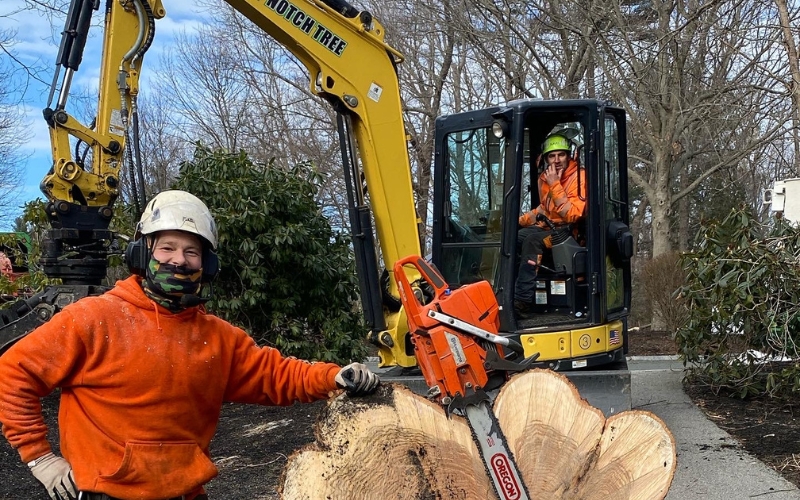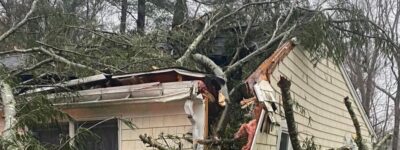The South Shore area of Massachusetts has many old estates with plenty of beautiful, large trees. Sometimes, these trees must come down, and removing a large tree poses several risks compared to smaller tree removal. Homeowners must work with their tree care company to prepare for large tree removal to ensure a safe and efficient process.
In this article, we will examine what homeowners must do when preparing for a large tree removal on the South Shore. We will also explain why homeowners ask us to remove large trees and ideas for what to do afterward.
Key Takeaways
- Large trees may need removal if they have become too old, continue encroaching on a neighbor’s property, or sustain heavy damage from a storm.
- A tree care company will explain what path the machinery and workers will take during the removal; remove any decorations or pet waste in the way before the removal.
- Depending on your location, where your tree is, and the size of the tree, you may need a permit for removal. Ask an arborist during the initial consultation about help with permits.
- Ask about add-on services like stump grinding or firewood during the initial consultation.
- Clearly identify and mark where any underground hazards might be, such as septic tanks. The tree removal team will avoid these areas to avoid damaging the equipment.
Determining When to Remove a Large Tree on the South Shore
Removing a large tree isn’t a decision to come to lightly. Large trees increase property value, and replacing the beauty they add to your property will take years. However, there are times when removing a large tree is the right decision.
Old Trees May No Longer Be Safe
Trees become weaker as they reach the end of their lives. These trees may begin leaning or have brittle bark and branches that can’t withstand the elements. Although there is much we can do to prolong a tree’s life, at some point, removal is the only option to protect your property and your family.
Consider Removing a Tree if it Encroaches on Someone Else’s Property
Large trees have expansive canopies and root systems. Although the large canopy will provide plenty of shade and an excellent habitat for birds and small mammals, it can encroach on public property or your neighbor’s yard. Regular pruning keeps the tree from entering a neighboring property, but it may become untenable to prune it every year. For some, annual pruning can become too costly. In other instances, improper pruning has left a tree unbalanced and weakened. In these cases, removal may be the best option.
Tree roots can pose a significant threat to structures on your property by exploiting any weaknesses they find. Roots are naturally drawn to moisture and will seek out water sources as they grow. If there are cracks or gaps in your foundation or water pipes, tree roots may enter your foundation in search of water, causing potential damage.
Heavy Tree Damage
Severe damage to a tree, such as from a storm, lightning strike, or a large object colliding with it, can also impact its health and stability. When a tree sustains heavy damage, removal may be the only viable option. In general, if 50 percent of the tree is damaged, it is unlikely to recover and may post a safety hazard. Heavily damaged trees can also become susceptible to diseases and pests, further compromising its structural integrity.
6 Tips for Preparing for a Large Tree Removal in the South Shore
Once you’ve decided to remove a large tree, you can begin the process of preparing for removal. Large tree removals require more equipment, and you’ll have to do more preparation for one than a smaller removal.
WARNING: Tree removal is dangerous and never something to DIY, especially when large trees are involved. Do not attempt to remove a large tree by yourself. Contact a tree care professional to handle removal and limit the risk to you, your family, and your property.
Tip #1: Talk With Your Arborist About the Space Needed for Equipment
During the initial consultation, the tree care specialist you talk to should outline the space requirements needed for the job. Some things you should ask about during the consultation include:
- The type of equipment they will use
- The path needed for equipment access
- The space the equipment will occupy
Knowing these details will help you determine what needs to be moved out of the way before removal day.
Tip #2: File for the Appropriate Permits
As a state, Massachusetts does not have any laws requiring permits. The only protection given by state law is to public shade trees, in which the tree warden is responsible for removal.
Depending on your municipality, you may have to acquire a permit to remove a tree from your yard. Different towns and townships will have different laws on the books about when you need a permit and how to apply for it. Many tree care companies will help you obtain a permit and walk you through the process.
The most relevant reasons why you may have to obtain a permit for large tree removal on the South Shore are:
- Protections for large trees: Large tree removal often requires a permit from local government authorities. This is because such removals can be disruptive and result in the loss of significant community assets. Many municipalities mandate a permit only if you can demonstrate that the tree poses a health risk or is a danger to property.
- Wetlands tree removal: Trees located in the wetlands of the South Shore are subject to specific protections, necessitating a permit for their removal. For instance, the town of Duxbury has detailed regulations governing tree removal in the wetlands. Compliance with these regulations ensures the protection of sensitive environmental areas.

Stump grinding is a popular add-on service after tree removal. We will grind the stump to below grade so you can use the area where the tree was for new landscaping needs.
Tip #3: Determine if There Are Any Add-On Services You Want
Having the tree removal team do any additional work during the first visit is more economical than having them come back a second time. Consider if you want any add-on services before or during your tree removal, such as:
- Stump grinding: After tree removal, you’ll be left with a stump, which can be a safety hazard and cause someone to trip. Stump grinding is a popular add-on service for tree removal, where the company grinds down a stump below ground level. With the stump effectively gone, you can use the area for other landscaping purposes.
- Firewood and woodchips: Many tree care companies will leave you with logs or firewood for an additional cost. You can also ask the team to leave woodchips behind that you can use for mulch.
- Arborist consultation: Before removing a large tree, having an ISA Certified Arborist inspect your trees may be a good idea to determine if removal is the best option.
Tip #4: Identify Potential Underground Hazards
To avoid breaking anything underground, most notably septic tanks, clearly explain where they are to the tree care company. A tree care company will be using heavy machinery for large tree removal, and knowing the spots to avoid will help avoid an expensive repair of a broken septic tank.
Tip #5: Speak With Neighbors if the Team Needs Access to Their Property
If a tree is near the property line or in tight spaces (as large trees often end up being), a tree care company may have to access the neighbor’s property to complete the removal. They should express this need to you during the initial consultation.
Before the tree removal day, speak with your neighbor to get their permission for any access the company may need.
Tip #6: Clean Up Before It’s Time for Removal
In the days leading up to the tree removal, prepare your yard to facilitate a smoother cleanup process for the team. Mow your lawn to simplify debris collection, and ensure all pet waste is cleared from the area. For safety, keep any pets securely leashed or indoors during the tree removal operation.
You’ll also want to remove anything near the tree and the path of machinery. This may include lawn decorations, birdbaths, bird feeders, and outdoor toys.
On the removal day, move your car from your driveway or in front of your house to give the company room to position their equipment and trucks.
What to Do After Large Tree Removal
Once the tree has been removed, you’ll have a fresh space ready for new landscaping opportunities. Consider planting a replacement tree, constructing a shed, or exploring other creative uses for the area. If you choose to plant a new tree, it’s advisable to add fresh soil and conduct a soil test to identify any nutrient deficiencies that may need to be addressed to ensure the healthy growth of your new tree.
Top Notch Tree Can Help With Tree Removals of Any Size
Attempting large tree removal on your own is highly dangerous due to the significant risk of injury. However, you can assist in preparing for the removal process by taking several steps: clean up pet waste and lawn decorations, secure the necessary permits, mark hazardous areas, and inform your
neighbors about the upcoming activity. These preparations will help ensure a smoother and safer tree removal process.
If you have a large tree you no longer want, our team at Top Notch Trees can help. We have the training and equipment to handle tree removal of any size safely and efficiently. Ready to get started? Call us at 781-871-8008 or request an estimate online today!
Frequently Asked Questions
What are the signs that a tree is at risk of falling?
Signs include visible leaning, cracks in the trunk, dead or falling branches, fungal growth at the base, and exposed roots. If you notice any of these signs, it’s important to consult with an arborist.
Can tree removal improve the health of surrounding trees?
Yes, removing a diseased or damaged tree can prevent the spread of pests and diseases to nearby trees and provide more resources like sunlight and water to the remaining healthy trees.
What happens to the wood after a tree is removed?
The wood can be processed in various ways. It can be cut into firewood, chipped into mulch, or hauled away. Discuss your preferences with the tree care company during your consultation.












